61 - 75 of 319 records
JM-149: Conundrum of the California Alien Land Law
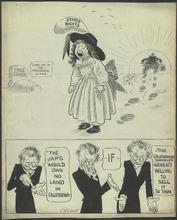
Description: The top panel of this cartoon depicts a little girl, "states' rights" crying over the grave of free silver. "Free silver" refers to the concept of the free coinage of silver, which was a popular idea for public policy among populists and other groups. Those in favor of free coinage of silver would argue that it would increase the circulation of currency, which would make wages higher and loan easier to obtain. Those against the free silver policy typically supported the gold standard, which was officially adopted by the United States in 1879. The gold standard limits the coinage of silver and other currency in circulation, because all currency must defined in the value of gold. Proponents of the gold standard argued it stabilized American currency, which allowed business to function. William Jennings Bryan, an influential American politician and Secretary of State (1913-1915), was an outspoken supporter of the free silver policy. In the top panel, William Jennings Bryan is abandoning states rights to go to California. William Jennings Bryan became involved with attempting to block discriminatory legislation against Japanese immigrants in California, such as the California Alien Land Law. This law placed restrictions of Japanese immigrants' legal ability to acquire and own property. Such discriminatory laws created a tense diplomatic relationship with Japan. As Secretary of State, William Jennings Bryan attempted to limit the impact of such legislation to improve relations between the United States and Japan. The idea behind many of these discriminatory laws in seen in the bottom panel. (Summary created by Mary Delano, MU History Intern, Spring 2018)
Member of: McCutcheon Editorial Cartoons - ALL (Collection)
Resource Type: Still Image
JM-170: Getting scareder and scareder!
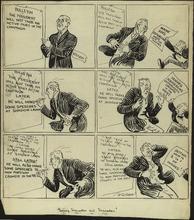
Description: This cartoon depicts President Woodrow Wilson planning his reelection campaign against Charles Evans Hughes during the presidential election of 1916. The first panel shows President Wilson calmly planning to take a passive role in the campaign until he receives a note that the state of Maine voted for Hughes by a narrow majority. The second panel shows a concerned Wilson receiving news that Hughes was addressing crowds in the West, whose vote Wilson was counting on for winning the election. The third panel shows a shocked Wilson learning Hughes was predicted to win the election by a large margin. Despite the assumptions made in this cartoon, Woodrow Wilson would defeat Hughes in the election of 1916, and he became the first democratic president to serve two consecutive terms in a row since Andrew Jackson. Woodrow Wilson appealed to many with his campaign slogan, "He kept us out of war," which appealed to many European (especially German) immigrants who did not wish to have the conflict of loyalty that would come from the United States joining World War I. Despite this, the United States would eventually enter World War I in 1917 during Wilson's second term. The Chicago Tribune published many articles in support of Hughes and his campaign. (Summary created by Mary Delano, MU History Intern, Spring 2018)
Member of: McCutcheon Editorial Cartoons - ALL (Collection)
Resource Type: Still Image
JM-175: Don't drop the pilot!
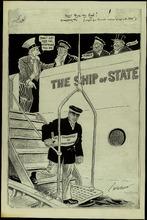
Description: This cartoon show Uncle Sam talking with President Wilson, Force, and Politics. Uncle Sam is insisting these parties do not allow someone to take the principle of arbitration outside the "ship of the state". Arbitration is a form of dispute resolution that gained popularity during the world wars. It was a quick and efficient way to resolve personal and commercial disputes without the time and effort associated with moving a claim through the traditional judicial system. The United States government began to use arbitration as a way to efficiently solve disputes involving wartime resources. (Summary created by Mary Delano, MU History Intern, Spring 2018)
Member of: McCutcheon Editorial Cartoons - ALL (Collection)
Resource Type: Still Image
JM-176: The daily bread line 1913
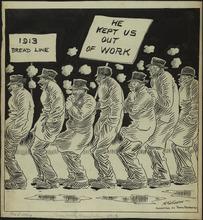
Description: This cartoon depicts a line of men waiting for food during the winter. One of them is holding a sign that says, "He kept us out of work". This sign is a play on President Wilson's campaign slogan, "He kept us out of war". There were some areas of United States economy struggling in 1913, making many individuals unemployed. In 1913, many criticized President Wilson's economic initiatives to be harmful to workers, and contributing to increased in unemployment. Such initiatives included further limiting commercial trusts and requiring investigations be made when particular businesses changed the wages of their workers. These investigations would be used to evaluate the costs of the factories, which was needed to determine guilt of criminal acts. In response to these initiatives, many factories closed operations or began to limit the changes that could be made to workers' wages. (Summary created by Mary Delano, MU History Intern, Spring 2018)
Member of: McCutcheon Editorial Cartoons - ALL (Collection)
Resource Type: Still Image
JM-161: The refining influence of speculating in war stock
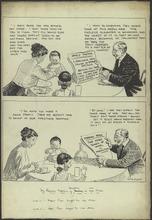
Description: This cartoon shows two impressions of the same family living in the United States during World War I. The top panel displays the family before they bought war stocks. The bottom panel shows them after they purchased war stocks. In the top panel, the mother and father are lamenting on the carnage of the war, causing the death of millions in Europe. The couple is horrified at the seemingly senseless loss of life. In the bottom panel, the couple are thrilled the war is expected to drag on, because the value of their war stocks will continue to increase and provide a temporarily sustained income to the family. This cartoon is meant to illustrate Americans' disturbing lack of empathy at the mere promise of profit. The United States notoriously made large profits throughout most of World War I selling weapons to use in the war, while remaining neutral in the conflict until 1917. (Summary created by Mary Delano, MU History Intern, Spring 2018)
Member of: McCutcheon Editorial Cartoons - ALL (Collection)
Resource Type: Still Image
JM-180: In the national army parade today, you are likely to see the man you'll all be cheering and voting for in years to come
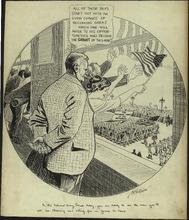
Description: This editorial cartoon depicts people watching the National Army of the Republic parade outside the window. A man wonders who will be "the Grant of this war." This is most likely one of the many parades held by military forces while the United States was fighting in WWI. This cartoon is captioned. "In the National Army Parade today, you are likely to see the man you'll all be cheering and voting for in years to come". The "Grant of this war" is a clear reference to Ulysses Grant, the eighteenth president of the United States from 1869 to 1977. Ulysses Grant was a general in the Civil War, and he is often given much credit for the Union's victory. After being appointed General-in-Chief by Abraham Lincoln in 1864, Grant would accept General Lee's surrender at Appomattox Court House, which effectively ended the Civil War. This cartoon suggests the future leaders of the United States would likely have served in World War I. (Summary created by Mary Delano, MU History Intern, Spring 2018)
Member of: McCutcheon Editorial Cartoons - ALL (Collection)
Resource Type: Still Image
JM-137: 1912 Presidential Election
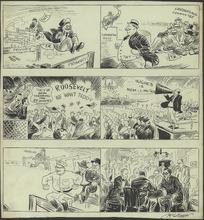
Description: This cartoon illustrates the events that occured in the presidential election of 1912. The top left panel shows former president, Theodore Roosevelt, obviously beating Taft in the primary elections. This reflected the fact that most voters at the time preferred Theodore Roosevelt to President Taft for reelection. The top right panel shows President Taft winning the primary election, because Roosevelt has been tackled by the credentials committee. The credentials committee was responsible for determining, which men were eligible to vote in the primary elections of 1912. The middle panel shows nominations for the Republican primary. The nomination of the left is for former President Theodore Roosevelt. The nomination on the right is for Charles Evans Hughes, former governor of New York. The bottom panel shows the race continuing, and a group of men sitting in a room. (Summary created by Mary Delano, MU History Intern, Spring 2018)
Member of: McCutcheon Editorial Cartoons - ALL (Collection)
Resource Type: Still Image
JM-128: Shake hands with my friend, Canadian Reciprocity
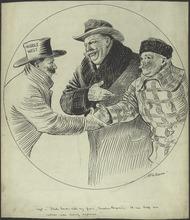
Description: Editorial cartoon depicting William Howard Taft encouraging a free trade accord between the Midwest and Canada.
Member of: McCutcheon Editorial Cartoons - ALL (Collection)
Resource Type: Still Image
JM-145: The Senate passes a parcels post bill
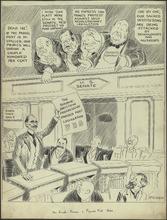
Description: This cartoon shows the US Senate passing the Post Office Appropriation Bill of 1912. The most controversial part of this legislation was the parcels post provision being held up in the comic. This provision divided the country into zones, which would be used to determine postage prices in the US. The provision was introduced by Senator Jonathan Bourne of Oregon to create uniform postage prices within specific areas of the United States. Senator Joseph Bristow of Kansas originally objected to the provision, claiming the price proposals of postage were too low to sustain. Eventually, the senators reached a compromise and the bill was passed with the maximum postage rate of 12 cents per first pound shipped within the total of eight zones created. This bill was thought to be beneficial to small businesses, regularized and lowering costs in specific zones. This bill was not well received by many within the US, particularly with some big business, as represented by the four large men in the top of the cartoon. One of these men reference former Senator Thomas Platt, an infamous political boss for the Republican party. The comment shows a shift occurring within Congress from conservative to more progressive policies during the 1910s. This shift is seen by the man commenting, "Darn those daily moosepapers". This comment is most likely a reference to the progressive policies of President Theodore Roosevelt, who founded the Bull-Moose party in 1912. (Summary created by Mary Delano, MU History Intern, Spring 2018)
Member of: McCutcheon Editorial Cartoons - ALL (Collection)
Resource Type: Still Image
JM-162: Why the U. S. must be strictly neutral
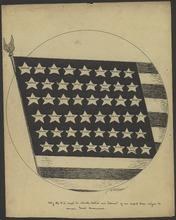
Description: This comic depicts the United States flag having forty eight stars, because Hawaii and Alaska would not become states until 1959. Each star has a ethnicity or nationality listed on it to represent the different types of immigrants assimilating and/or remaining in the United States after moving from different locations. The quote below the comment reads, "Why the US must be strictly neutral and tolerant if we expect these citizens to remain good Americans." This cartoon suggests that if the United States were to enter World War I, it would outrage the immigrants of the countries upon which the United States declared war. This was a common concern of United States citizens before the United States entered World War I. (Summary created by Mary Delano, MU History Intern, Spring 2018)
Member of: McCutcheon Editorial Cartoons - ALL (Collection)
Resource Type: Still Image
JM-160: The Christmas Carol that was not rehearsed
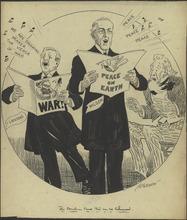
Description: This cartoon highlights and humorizes the lack of agreement between President Woodrow Wilson and his Secretary of State, Robert Lansing. In December of 1916, President Wilson issued a peace note, explaining his position on the United States involvement in World War I. President Wilson wished to help negotiate peace talks between the allies and Germany, which had been recently suggested by Germany. President Wilson also wished to keep the United State a neutral party within World War I, not providing military support to either side. In this peace note, Lansing offered an addendum saying, "The United States already in the war economically, was being drawn in militaristically." This caused a great upset in the Wilson administration as the President tried to emphasize the need for peace without completely discrediting his Secretary of State. The cartoon highlights this discomfort by showing Lansing and President Wilson essentially singing a different tune. A shocked Uncle Sam (citizens of the United States) sits listening to the pair and is unsure what to think of the spectacle. This cartoon uses Christmas carols as a humorous reminder that this incident occurred within the week before Christmas in December of 1916, less than six months before the United States would eventually enter World War I. (Summary created by Mary Delano, MU History Intern, Spring 2018)
Member of: McCutcheon Editorial Cartoons - ALL (Collection)
Resource Type: Still Image
JM-164: Will there be enough to go round?
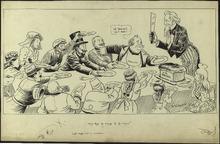
Description: This cartoon depicts Uncle Sam trying to divide "U.S. Bread" among various nations. In 1915, World War I was being fought in Europe, but the United States was maintaining a neutral position. Despite its neutrality, the United States supplied resources and arms to nations during the war. All of the countries sitting at the table are nations who lobbied for resources from the United States during the war. England is attempting to block Germany's chance of receiving resources from Uncle Sam. This is representative the attempts of the British government to limit the United States aid to Allied Powers, most often England. The United States is also sitting at the table, looking worried about sharing the beard with other nations. The United States distributing more resources than it could afford was a fear for many Americans in the 1910s. (Summary created by Mary Delano, MU History Intern, Spring 2018)
Member of: McCutcheon Editorial Cartoons - ALL (Collection)
Resource Type: Still Image
JM-141: The great spring take-off

Description: This is a satirical piece commenting on a series of tariffs on fabrics, especially those used in the clothing industry. A tariff on cotton caused great outrage among the middle class, especially women. Most antagonists of the bill stated cotton was too essential to clothe the people of the United States to unnecessarily drive up the cost. Unlike other fabrics, wool had been able to move through the United States without having a new tariff placed upon it. It appeals to the common man's (and woman's) feelings of the lack of need for wool rather than cotton esp in the summer months like May. The author is writing to hear then President Taft's and former President Roosevelt's opinions. This is because President Taft and his former leader, Theodore Roosevelt both favored the passed tariffs on fabrics. President Taft himself signed the tariff on cotton and was heavily in favor of supporting tariffs rather than income taxes, which were just beginning to be commonly employed in the United States. (Summary created by Mary Delano, MU History Intern, Spring 2018)
Member of: McCutcheon Editorial Cartoons - ALL (Collection)
Resource Type: Still Image
JM-191: Don't wreck that car!

Description: This cartoon shows railroad employees fighting with railroad employers in a car named "U.S. Prosperity", which is carrying the United States in the back seat. There were many railroad employee strikes in the first half of the twentieth century, usually protesting against poor pay and/or working conditions. Railroads were one of the most efficient methods of transportation, especially the transportation of goods. This made railroads critical to the health of the United States economy. In the corner of this cartoon, President Woodrow is yelling at the employers and employees to not wreck the car. While the role was not extensive, the government did take an interest in these railroad disputes, and made sure they were eventually settled. This intervention was usually performed to ensure the railroads would continue to ship American goods throughout the United States. (Summary created by Mary Delano, MU History Intern, Spring 2018)
Member of: McCutcheon Editorial Cartoons - ALL (Collection)
Resource Type: Still Image
JM-173: National defense

Description: The top panel of this cartoon depicts Congress attempting to slow Uncle Sam driving a automobile and is used to represent the fast moving sentiments for national defense. The donkey is being used to suggest the actions of Congress are aligned with the democrat interests of the time. National defense is passing through pork and casting it to the side. The word "pork" is being used to describe projects and/or funding given by Congress to benefit certain areas or populations in the country. An example of pork would be Congress awarding money for a damn to be built in a specific state. The bottom panel has two possibilities that stem from the sentiments of the top panel. The scenario on the left depicts a man dissatisfied with increased taxes that Congress would have to impose to fund national defense interests. The scenario on the right shows the same man having to pay tributes to an invader. The bottom panel suggests that tax increases for national defense are in the best financial and personal interest of citizens. (Summary created by Mary Delano, MU History Intern, Spring 2018)
Member of: McCutcheon Editorial Cartoons - ALL (Collection)
Resource Type: Still Image
Pagination
- Previous page
- Page 5
- Next page